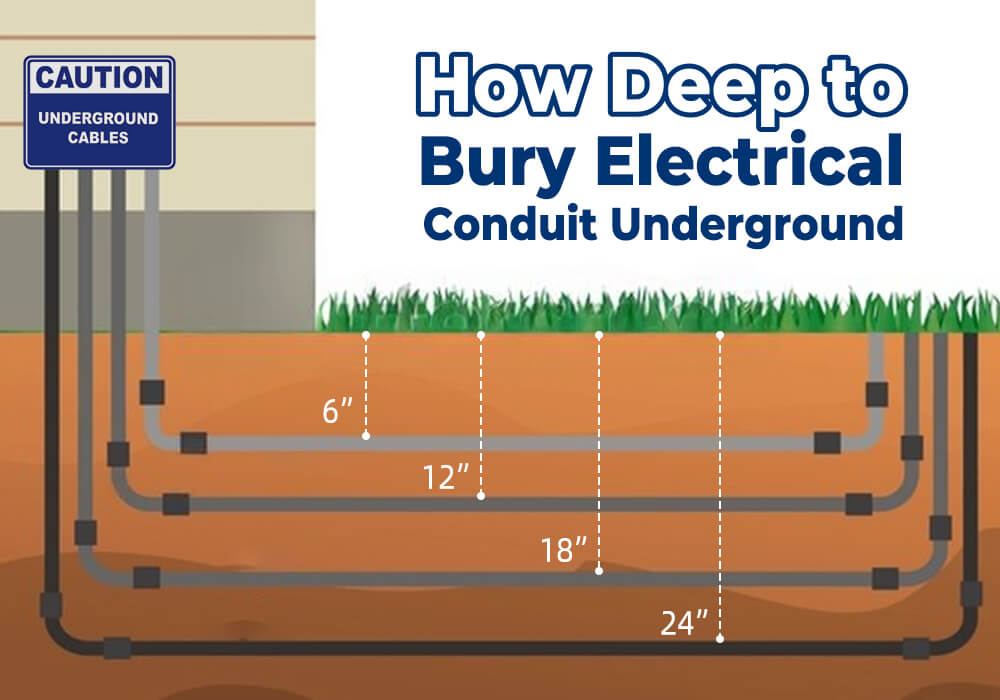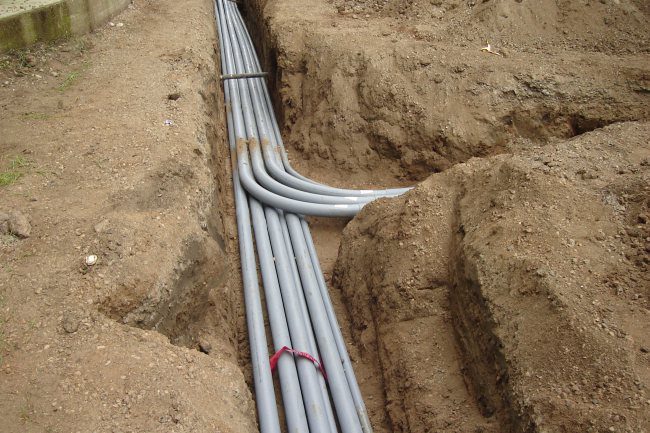how deep to bury electrical conduit underground?
The National Electrical Code (NEC) provides guidelines for burying electrical cable and wiring, commonly referred to as direct burial installations.
These depth requirements are outlined in table 300.5 of the NEC. The burial depth varies between 4 inches and 24 inches, depending on the specific wiring method employed.
| Article 300 – General Requirements for Wiring Methods and Materials | ||||||||||
|---|---|---|---|---|---|---|---|---|---|---|
| Table 300.5 Minimum Cover Requirements, 0 to 1000 Volts, Nominal, Burial in Millimeters (Inches) | ||||||||||
| Type of Wiring Method or Circuit | ||||||||||
| Location of Wiring Method or Circuit | Column 1 Direct Burial Cables or Conductors |
Column 2 Rigid Metal Conduit or Intermediate Metal Conduit |
Column 3 Nonmetallic Raceways Listed for Direct Burial Without Concrete Encasement or Other Approved Raceways |
Column 4 Residential Branch Circuits Rated 120 Volts or Less with GCFI Protection and Maximum Overcurrent Protection of 20 Amperes |
Column 5 Circuits for Control of Irrigation and Landscape Lighting Limited to Not More Than 30 Volts and Installed with Type UF or in Other Identified Cable or Raceway |
|||||
| mm | in. | mm | in. | mm | in. | mm | in. | mm | in. | |
| All locations not specified below | 600 | 24 | 150 | 6 | 450 | 18 | 300 | 12 | 150 a,b | 6 a,b |
| In trench below 50 mm (2 in.) | 450 | 18 | 150 | 6 | 300 | 12 | 150 | 6 | 150 | 6 |
| Under a building | 0 | 0 | 0 | 0 | 0 | 0 | 0 | 0 | 0 | 0 |
| (in raceway or Type MC or Type MI cable indentified for direct burial) | (in raceway or Type MC or Type MI cable indentified for direct burial) | (in raceway or Type MC or Type MI cable indentified for direct burial) | ||||||||
| Under minimum of 102 mm (4 in.) thick concrete exterior slab with no vehicular traffic and the slab extending not less than 152 mm (6 in.) beyond the underground installation | 450 | 18 | 100 | 4 | 100 | 4 | 150 | 6 | 150 | 6 |
| (direct burial) | (direct burial) | |||||||||
| 100 | 4 | 100 | 4 | |||||||
| (in raceway) | (in raceway) | |||||||||
The Underground Conduit Options:
PVC conduit – One of the most widely used types of conduit for underground installation.
Made of rigid polyvinyl chloride (PVC) piping. Durable, corrosion resistant, and relatively affordable. Available in various sizes.
HDPE conduit – Made of high-density polyethylene (HDPE), it is flexible and easier to install than rigid PVC conduit. Often used for direct burial applications. Resistant to corrosion and very durable.
Steel conduit – Galvanized rigid steel conduit provides maximum durability underground but is heavier and more expensive to install than PVC or HDPE. Highly resistant to corrosion.
Fiberglass conduit – Non-metallic and corrosion resistant. Good alternative where non-conductive and non-magnetic properties are required. More expensive than PVC.
ENT (electrical nonmetallic tubing) – Flexible PVC tubing used as a low-cost alternative to rigid conduit, typically for short underground runs. Easier to install than rigid conduit but provides less physical protection.
Pre-bent conduit – Available for PVC and HDPE. The pre-bent design facilitates installation along curved alignments without having to form bends in the field.
how deep to bury electrical conduit underground? Read More »


